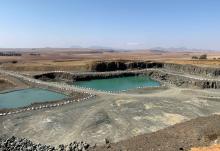
When South African mining regulator, the Department of Mineral Resources (DMR), promulgated the mandatory use of proximity detection systems (PDS), collision avoidance systems (CAS) and motion inhibitors in December 2014, the country’s quarrying sector previously highlighted some uncertainty and concerns.
However, subsequent to a lengthy consultation process between various stakeholders, significant progress has been made as far as the adoption of these safety technologies at quarries is concerned. Letisha Van Den Berg, health and safety at
“We are currently engaging with the Chamber of Mines (now Minerals Council), original equipment manufacturers (OEMs) and small-scale mines to ensure the risk evaluation is done properly through an Australian company, Mitacom. This is aimed at having a user guide with precise specifications required for specific needs from a specific mine, and not off the shelve product purchases,” says Van Den Berg.
“The process cannot be manipulated to reduce trackless mobile machinery (TMM) risks. `We have selected four
In terms of the deadline for compliance, Van Den Berg explains that by now every operation should have conducted its assessment on TMM to determine the level of risk – if it is significant there is need to install warning devices (proximity detection) but not CAS (collision avoidance systems). The deadline for collision avoidance systems was initially set for 2019, but has subsequently been pushed to July 2020. However, Van Den Berg reiterates that there is no formal approval and sign off from the DMR on these dates.
The regulation states that the PDS needs to warn the driver that there is another machine or a person in its proximity, which the mine/quarry must have already identified as an unwanted event. “Your risk assessment determines your adoption; our risk evaluation came out as not significant but we will still trial the collision avoidance systems to determine if the technology can further reduce our TMM risks,” sys Van Den Berg.
The regulation further says, if the driver of the vehicle does not respond to the warning, the vehicle needs to come to a slowdown and standstill (CAS). This is the part of the regulation operations need to comply with by July 2020, if their risk assessment and user requirement specification indicates the need.
The quarrying industry has previously raised concerns regarding the lack of consultation and also highlighted that the promulgation of PDSs, CAS and motion inhibitors did not precede the necessary studies on quarries.
“This was the industry’s viewpoint during the early days of the promulgation of the legislation. However, since 2017 the Minerals Council has worked with us to find cost-effective and operable solutions,” says Van Den Berg.
The Mining Industry Occupational Safety and Health (MOSH) is also working closely with the quarrying industry to find traffic management solutions that will help reduce the need for installation of PDS/CAS units. If an operation reduces its TMM, both small and large, and pedestrian interaction, it can avoid the installation of PDS/CAS systems.
“I must also stress that as a small-scale mine you must be committed to the entire process and take time out to attend the various workshops regarding traffic management and PDS/CAS systems. Invites are normally sent through the industry board, ASPASA, but you can contact any MOSH individual for assistance and be added to the invite list,” she says.
The quarrying industry has previously lobbied for a differentiation between quarries and large-scale mining operations for a number of years and believed that this would help it regulate and implement codes of practices (COPs) better.
“We are in the process of updating Chapter 2 (responsibilities and appointments) and 15 (competency and training) of the Mine Health and Safety Act (MHSA) through the Mine Health and Safety Council (MHSC), the Mining Regulation Advisory Committee (MRAC) and the DMR. Here we have made some major steps in demonstrating the need for surface mines being split by size through a risk assessment process. Nothing has been approved by the legislator or MRAC but the draft changes incorporate this challenge,” she says.
If this is accepted, approved and promulgated then the industry would have won a huge battle. “But, I have to caution – this does not mean that operations don’t have to comply with COPs. A mine determines its own risk and places control measures to reduce the risk – that makes a COP site specific,” she says.
“It is of sheer importance to abide by your own rules. One challenge that remains is that some auditors assume that one solution will fix every mine’s risk and that is far from the truth. If a large underground mine finds solutions for PDS/CAS, it does not mean that these can be replicated in a surface operation – that is a lesson we have learnt the hard way,” concludes Van Den Berg.






